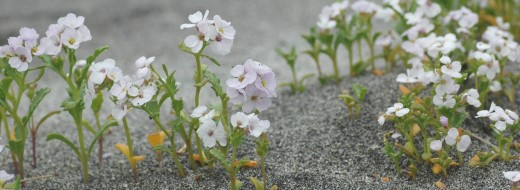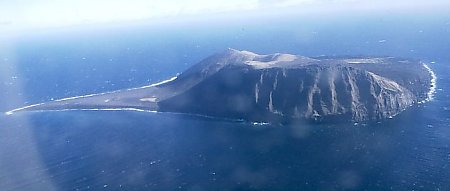

View larger. | The new-born island of Surtsey, off the coast of Iceland, on November 30, 1963. Howell Williams captured this photo 16 days after the start of the eruption that created Surtsey. Image via NOAA.
November 14, 1963. On this date, a cook aboard a trawler called Ísleifur II – sailing south of Iceland – spotted a column of dark smoke rising from the surface of the sea. The ship’s captain thought it be a boat on fire and turned his vessel to investigate. What they found was an island in the process of being born. There were explosive volcanic eruptions originating from below the sea surface, belching black columns of ash.
The 2019 lunar calendars are here! Order yours before they’re gone. Makes a great gift.
The new island was later named Surtsey, for Surtr, a fire jötunn (a mythological race of Norse giants).
The eruption continued for several years. After just a few days, the new island measured over 1,640 feet (500 meters) in length and had reached a height above the sea surface of 147 feet (45 meters).
And it continued to grow. By April of 1965, ash had blocked sea water from the crater area. Lava flows became prominent, forming a hard cap of solid rocks over the lower slopes of the new island. This prevented the waves from washing away the island.
The eruption ultimately lasted 3 1/2 years, ending in June 1967.
New island off the coast of Pakistan, one day after it emerged from the waves on September 24, 2013. Image via BBC World News Facebook.
Surtsey is only the most famous, or one of the most famous, of the islands known to have emerged from below the sea surface in living memory. For example, on September 24, 2013, an earthquake caused the birth of a new mud island off Pakistan’s southern coast.
Another famous example from the 20th century is Anak Krakatau (“child of Krakatoa”), which formed in the flooded caldera of that Indonesian volcano in 1930.
There is also Home Reef in the South Pacific, and there are many others.

The first plants discovered at Surtsey’s shoreline were sea rockets (Cakile arctica) in 1965. Read about the colonization of Surtsey by plants from the Surtsey Research Society.

Surtsey in 1999, via Wikimedia Commons.
Today, wind and wave erosion eat away at Surtsey steadily, reclaiming some of its land mass. As of 2002, Surtsey’s surface area was 1.4 square kilometers (0.54 square miles), according to the Surtsey Research Society. Scientists estimate that, if the current rate of erosion doesn’t change, the island will be mostly at or below sea level by 2100. At that time, though, the tougher core of the island will be exposed. Afterwards, Surtsey might last several more centuries.
The birth of this new landform wasn’t the end of Surtsey’s story. In the first spring after Surtsey emerged from the sea surface, seeds and other plant parts were found washed up on the newly formed shore. In the spring of 1965, the first higher plant was discovered at the shoreline: a sea rocket (Cakile arctica).
Since then, Surtsey – whose north shore touches the Arctic Circle – has provided scientists a laboratory to observe how plants and animals establish themselves in new territory.
In 1965, it was declared a nature reserve for the study of ecological succession, that is, how plants, insects, birds, seals, and other forms of life have since established themselves on the island over time.
Bottom line: New islands are sometimes born, and frequently disappear again, on human timescales. The most famous new island in living memory may be Surtsey, off the southern coast of Iceland, which began to emerge on November 14, 1963.
from EarthSky https://ift.tt/2zawb8x


View larger. | The new-born island of Surtsey, off the coast of Iceland, on November 30, 1963. Howell Williams captured this photo 16 days after the start of the eruption that created Surtsey. Image via NOAA.
November 14, 1963. On this date, a cook aboard a trawler called Ísleifur II – sailing south of Iceland – spotted a column of dark smoke rising from the surface of the sea. The ship’s captain thought it be a boat on fire and turned his vessel to investigate. What they found was an island in the process of being born. There were explosive volcanic eruptions originating from below the sea surface, belching black columns of ash.
The 2019 lunar calendars are here! Order yours before they’re gone. Makes a great gift.
The new island was later named Surtsey, for Surtr, a fire jötunn (a mythological race of Norse giants).
The eruption continued for several years. After just a few days, the new island measured over 1,640 feet (500 meters) in length and had reached a height above the sea surface of 147 feet (45 meters).
And it continued to grow. By April of 1965, ash had blocked sea water from the crater area. Lava flows became prominent, forming a hard cap of solid rocks over the lower slopes of the new island. This prevented the waves from washing away the island.
The eruption ultimately lasted 3 1/2 years, ending in June 1967.
New island off the coast of Pakistan, one day after it emerged from the waves on September 24, 2013. Image via BBC World News Facebook.
Surtsey is only the most famous, or one of the most famous, of the islands known to have emerged from below the sea surface in living memory. For example, on September 24, 2013, an earthquake caused the birth of a new mud island off Pakistan’s southern coast.
Another famous example from the 20th century is Anak Krakatau (“child of Krakatoa”), which formed in the flooded caldera of that Indonesian volcano in 1930.
There is also Home Reef in the South Pacific, and there are many others.

The first plants discovered at Surtsey’s shoreline were sea rockets (Cakile arctica) in 1965. Read about the colonization of Surtsey by plants from the Surtsey Research Society.

Surtsey in 1999, via Wikimedia Commons.
Today, wind and wave erosion eat away at Surtsey steadily, reclaiming some of its land mass. As of 2002, Surtsey’s surface area was 1.4 square kilometers (0.54 square miles), according to the Surtsey Research Society. Scientists estimate that, if the current rate of erosion doesn’t change, the island will be mostly at or below sea level by 2100. At that time, though, the tougher core of the island will be exposed. Afterwards, Surtsey might last several more centuries.
The birth of this new landform wasn’t the end of Surtsey’s story. In the first spring after Surtsey emerged from the sea surface, seeds and other plant parts were found washed up on the newly formed shore. In the spring of 1965, the first higher plant was discovered at the shoreline: a sea rocket (Cakile arctica).
Since then, Surtsey – whose north shore touches the Arctic Circle – has provided scientists a laboratory to observe how plants and animals establish themselves in new territory.
In 1965, it was declared a nature reserve for the study of ecological succession, that is, how plants, insects, birds, seals, and other forms of life have since established themselves on the island over time.
Bottom line: New islands are sometimes born, and frequently disappear again, on human timescales. The most famous new island in living memory may be Surtsey, off the southern coast of Iceland, which began to emerge on November 14, 1963.
from EarthSky https://ift.tt/2zawb8x

Aucun commentaire:
Enregistrer un commentaire